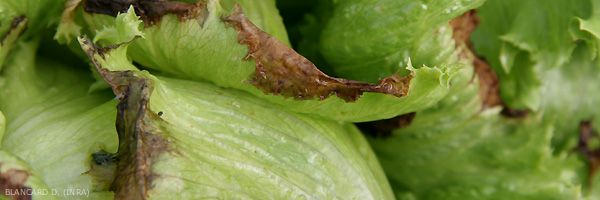
Marginal necrosis
(tipburn)
Under the name marginal necrosis or tipburn are grouped two types of abiotic problems (physiological or non-parasitic) affecting lettuce grown in soil, as in soil. They are manifested by necrosis starting at the periphery of the leaves of the heart or the crown of salads, and whose expression seems to be linked to the combination of genetic and environmental factors, more or less in relation to calcium and in particular its transport in plants.
Marginal necrosis of the leaves bordering the apple and of the leaves of the heart
( internal marginal necrosis , internal tipburn ) (Figures 1 to 8)
- Symptoms :
- development of wet necrosis on young leaves;
- translucent appearance of the small veins located at the periphery of the leaf blade which take on a brown tint;
- diffuse browning of surrounding tissues and installation of soft rot;
- sometimes in places there are tiny spots and browning of short portions of veins.
To observe this problem on salads with “closed” apples, it is necessary to cut the apple. Rather, it manifests itself as salads approach maturity. At this stage, the leaves of the heart protected by those of the crown, and therefore less ventilated, are more humid.
- Explanatory mechanism :
Calcium in salads: it is a component of cell walls acting as a binder of the walls of adjacent cells. This element is also involved in cell division and elongation. It is passively taken up by young roots and transported via xylem vessels. Once inside the tissues, it is not mobile. So that it can migrate sufficiently in the salads towards the growing tissues, it is essential that these sweat. In the end, the lack of leaf calcium is not due to a too low quantity of this element at the level of the roots, but to several environmental factors. Under these conditions, lesions are caused by the collapse of membranes and cell walls.
-
Possible causes :
- ambient humidity too high;
- insufficient plant transpiration;
- limited ventilation of shelters;
- imbalanced nitrogenous manure;
- prolonged period of cloudy weather, fog;
- limited root development;
- too rapid growth of young leaves exposed to strong light intensities during the day ...
- Actions to be taken *
- carry out a soil analysis before planting in order to ensure balanced manure and avoid excess nitrogen and calcium deficiencies;
- control the calcium concentration of your nutrient solution
- avoid growing susceptible varieties, sometimes showing a limited root system;
- promote plant transpiration;
- ventilate the shelters as much as possible (opening the doors, ventilators);
- limit or even stop irrigations during periods of high humidity;
- promote the proper functioning of plants as much as possible;
- control plant growth, prevent it from being too rapid;
- avoid excess supplemental lighting;
- control carbon dioxide (CO2) enrichment;
- counteract sudden rises in temperature by light bathing ...
* When the problem has arisen, no measure can remedy the symptoms that have appeared on the salads.
Marginal necrosis of crown leaves
( dry marginal necrosis or tipburn ) (Figures 9 to 11)
- Symptoms :
- development of more or less extensive brown to black lesions appearing at the edge of the rather low leaf blades;
- small veins nearby may also turn brown;
- subsequently, these rather localized lesions spread rapidly;
- eventually, brown patches, rather dry in appearance, progressively gain the interior of the lamina;
- more or less marked yellowing of the limbus on the margins of the lesions;
- We could associate it with "latex necrosis" which also results in a dry deterioration of the periphery of the limbus, but which is preceded by bursting of the vessels and the local emission of this milky compound.
- Possible causes :
- The causes of this problem seem less well defined; it would be partly linked to an accumulation of salts at the periphery of the limbus, where the veins end.
- a reduced water supply to the leaves, leading to a decrease in calcium flux and / or a rupture of the laticiferous channels releasing toxic latex;
- insufficient plant water supply;
- excessive ventilation;
- too rapid evolution of climatic conditions towards heat and drought;
- poor condition of the root system (poor installation, damage linked to biotic or abiotic attacks - excess salinity);
- inappropriate nitrogen fertilization and / or too much evaporation due to the wind or excessive ventilation under shelters ...
- Actions to be taken :
- carry out a soil analysis before planting in order to ensure balanced manure and avoid excess nitrogen and calcium deficiencies;
- prepare the soil well and promote good plant rooting;
- choose a variety with a vigorous root system that is often less sensitive;
- ensure an optimal water supply especially during dry climatic periods;
- above ground, avoid excessively high ECs (electro-conductivity);
- control the salinity of the nutrient solution, the water supply and the ventilation of shelters, in particular when the humidity is low ...
Note that tipburn could also appear after harvest, during storage, and even among consumers. In addition to depreciating the commercial quality of salads, these various necroses constitute excellent nutritional bases from which opportunistic microorganisms, such as Botrytis cinerea (figure 12), various bacteria, settle. They cause rotting of the leaf blade and apple, especially if the ambient humidity is high. It should also be noted that salads, especially lettuce, although moderately sensitive to salinity, may show comparable symptoms following sudden increases in soil salt concentration.





